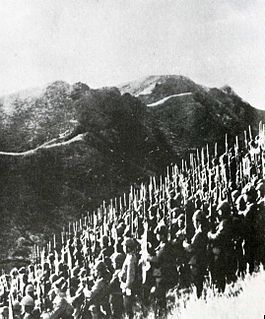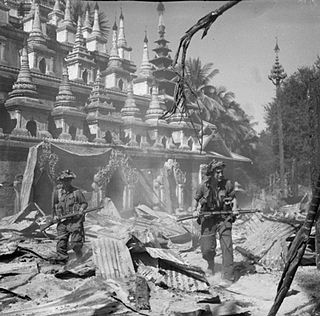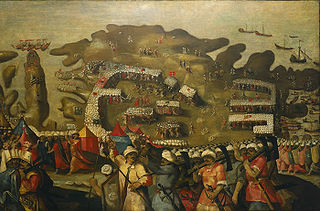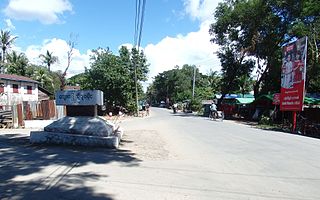
The British Fourteenth Army was a multi-national force comprising units from Commonwealth countries during World War II. Many of its units were from the Indian Army as well as British units and there were also significant contributions from West and East African divisions within the British Army. It was often referred to as the "Forgotten Army" because its operations in the Burma Campaign were overlooked by the contemporary press, and remained more obscure than those of the corresponding formations in Europe for long after the war. For most of the Army's existence, it was commanded by Lieutenant-General William Slim.

The Burma Campaign was a series of battles fought in the British colony of Burma, South-East Asian theatre of World War II, primarily involving the forces of the British Empire and China, with support from the United States, against the invading forces of Imperial Japan, Thailand, and the Indian National Army. British Empire forces peaked at around 1,000,000 land and air forces, and were drawn primarily from British India, with British Army forces, 100,000 East and West African colonial troops, and smaller numbers of land and air forces from several other Dominions and Colonies. The Burma Independence Army was trained by the Japanese and spearheaded the initial attacks against British Empire forces.

During World War II, Operation Dracula was the name given to an airborne and amphibious attack on Rangoon by British, American and Indian forces, part of the Burma Campaign.

The Battle of the Admin Box took place on the southern front of the Burma Campaign from 5 to 23 February 1944, in the South-East Asian Theatre of World War II.

The concurrent Battle of Meiktila and Battle of Mandalay were decisive engagements near the end of the Burma Campaign. Collectively, they are sometimes referred to as the Battle of Central Burma. Despite logistical difficulties, the Allies were able to deploy large armoured and mechanised forces in Central Burma, and also possessed air supremacy. Most of the Japanese forces in Burma were destroyed during the battles, allowing the Allies to later recapture the capital, Rangoon, and reoccupy most of the country with little organised opposition.

The 17th Infantry Division is a formation of the Indian Army. During World War II, it had the distinction of being continually in combat during the three-year-long Burma Campaign.

The 7th Indian Infantry Division was a war-formed infantry division, part of the Indian Army during World War II that saw service in the Burma Campaign.

The Battle of Pakokku and Irrawaddy River operations were a series of battles fought between the British Indian Army and the Imperial Japanese Army and allied forces over the successful Allied Burma Campaign on the China Burma India Theater during World War II. The battles and operations were instrumental in facilitating the eventual capture of Rangoon in summer 1945.

The 33rd Division was an infantry division of the Imperial Japanese Army. Its call sign was the Bow Division. The 33rd Division was raised in Utsunomiya, Tochigi prefecture, simultaneously with 32nd, 34th, 35th, 36th and 37th Divisions. Its headquarters were initially in Sendai. It was raised from conscripts largely from the northern Kantō prefectures of Tochigi, Ibaraki and Gunma.
The Battle of Toungoo, was one of the key battles in the Battle of Yunnan-Burma Road in the Burma Campaign of World War II and Second Sino-Japanese War. The failure to hold the city of Toungoo opened up the route for the Japanese to make their lunge to Lashio around the allied flank and into the Chinese rear.
The Battles and Operations involving the Indian National Army during World War II were all fought in the South-East Asian theatre. These range from the earliest deployments of the INA's preceding units in espionage during Malayan Campaign in 1942, through the more substantial commitments during the Japanese Ha Go and U Go offensives in the Upper Burma and Manipur region, to the defensive battles during the Allied Burma Campaign. The INA's brother unit in Europe, the Indische Legion did not see any substantial deployment although some were engaged in Atlantic wall duties, special operations in Persia and Afghanistan, and later a small deployment in Italy. The INA was not considered a significant military threat. However, it was deemed a significant strategic threat especially to the Indian Army, with Wavell describing it as a target of prime importance.

The Japanese conquest of Burma was the opening chapter of the Burma Campaign in the South-East Asian Theatre of World War II, which took place over four years from 1942 to 1945. During the first year of the campaign, the Japanese Army drove British Empire and Chinese forces out of Burma, then began the Japanese occupation of Burma and formed a nominally independent Burmese administrative government.

The Burma Campaign in the South-East Asian Theatre of World War II took place over four years from 1942 to 1945. During the first year of the campaign, the Imperial Japanese Army with aid from Burmese insurgents had driven British forces and Chinese forces out of Burma, and occupied most of the country. From May to December 1942, most active campaigning ceased as the monsoon rains made tactical movement almost impossible in the forested and mountainous border between India and Burma, and both the Allies and Japanese faced severe logistical constraints.

The fighting in the Burma Campaign in 1944 was among the most severe in the South-East Asian Theatre of World War II. It took place along the borders between Burma and India, and Burma and China, and involved the British Commonwealth, Chinese and United States forces, against the forces of Imperial Japan and the Indian National Army. British Commonwealth land forces were drawn primarily from the United Kingdom, British India and Africa.

The Japanese 15th Army was an army of the Imperial Japanese Army during World War II. It was involved in the invasion of Burma in December 1941 and served in that country for most of its war service.

The Burma Campaign in the South-East Asian Theatre of World War II was fought primarily by British Commonwealth, Chinese and United States forces against the forces of Imperial Japan, who were assisted to some degree by Thailand, the Burmese Independence Army and the Indian National Army. The British Commonwealth land forces were drawn primarily from the United Kingdom, British India and Africa.

The Japanese 33rd Army was an army of the Imperial Japanese Army during the final days of World War II.
The Battle of Bilin River was the first major battle of the Burma Campaign in World War II. Fought between 14 and 18 February 1942, the battle was a tactical victory for Japan over the British Indian Army, and it led to a decisive victory for Japan immediately afterwards at the Battle of Sittang Bridge.
The British Indian XXXIII Corps was a corps-sized formation of the Indian Army during World War II. It was disbanded and the headquarters was recreated as an Army headquarters in 1945.

The Battle of the Sittang Bend and the Japanese Breakout across Pegu Yomas were linked Japanese military operations during the Burma Campaign, which took place nearly at the end of World War II. Surviving elements of the Imperial Japanese Army who had been driven into the Pegu Yoma attempted to break out eastwards, to join other Japanese troops retreating from the British forces. The break-out was the objective of the Japanese Twenty-Eighth Army with support at first from the Thirty-third Army and later the Fifteenth Army. As a preliminary, the Japanese Thirty-third Army attacked Allied positions in the Sittang Bend, near the mouth of the river, to distract the Allies. The British had been alerted to the break-out attempt and it ended calamitously for the Japanese, who suffered many losses, with some formations being wiped out.



























